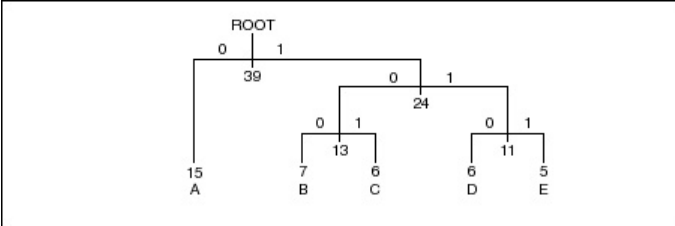Huffman coding shares most characteristics of Shannon-Fano coding. It creates variable-length codes that are an integral number of bits. Symbols with higher probabilities get shorter codes. Huffman codes have the unique prefix attribute, which means they can be correctly decoded despite being variable length. Decoding a stream of Huffman codes is generally done by following a binary decoder tree
Building the Huffman decoding tree is done using a completely different algorithm from that of the Shannon-Fano method. The Shannon-Fano tree is built from the top down, starting by assigning the most significant bits to each code and working down the tree until finished. Huffman codes are built from the bottom up, starting with the leaves of the tree and working progressively closer to the root.
The procedure for building the tree is simple and elegant. The individual symbols are laid out as a string of leaf nodes that are going to be connected by a binary tree. Each node has a weight, which is simply the frequency or probability of the symbol’s appearance. The tree is then built with the following steps
- The two free nodes with the lowest weights are located.
- A parent node for these two nodes is created. It is assigned a weight equal to the sum of the two child nodes.
- The parent node is added to the list of free nodes, and the two child nodes are removed from the list.
- One of the child nodes is designated as the path taken from the parent node when decoding a 0 bit. The other is arbitrarily set to the 1 bit.
- The previous steps are repeated until only one free node is left. This free node is designated the root of the tree.
The five symbols in our message are laid out, along with their frequencies, as shown:
| 15 | 7 | 6 | 6 | 5 |
| A | B | C | D | E |
These five nodes are going to end up as the leaves of the decoding tree. When the process first starts, they make up the entire list of free nodes.
The first pass through the tree identifies the two free nodes with the lowest weights: D and E, with weights of 6 and 5. (The tie between C and D was broken arbitrarily. While the way that ties are broken affects the final value of the codes, it will not affect the compression ratio achieved.) These two nodes are joined to a parent node, which is assigned a weight of 11. Nodes D and E are then removed from the free list.
Once this step is complete, we know what the least significant bits in the codes for D and E are going to be. D is assigned to the 0 branch of the parent node, and E is assigned to the 1 branch. These two bits will be the LSBs of the resulting codes.
On the next pass through the list of free nodes, the B and C nodes are picked as the two with the lowest weight. These are then attached to a new parent node. The parent node is assigned a weight of 13, and B and C are removed from the free node list. At this point, the tree looks like this

On the next pass, the two nodes with the lowest weights are the parent nodes for the B/C and D/E pairs. These are tied together with a new parent node, which is assigned a weight of 24, and the children are removed from the free list. At this point, we have assigned two bits each to the Huffman codes for B, C, D, and E, and we have yet to assign a single bit to the code for A.
Finally, on the last pass, only two free nodes are left. The parent with a weight of 24 is tied with the A node to create a new parent with a weight of 39. After removing the two child nodes from the free list, we are left with just one parent, meaning the tree is complete. The final result looks like this

To determine the code for a given symbol, we have to walk from the leaf node to the root of the Huffman tree, accumulating new bits as we pass through each parent node. Unfortunately, the bits are returned to us in the reverse order that we want them, which means we have to push the bits onto a stack, then pop them off to generate the code. This strategy gives our message the code structure shown in the following table.
| A | 0 |
| B | 100 |
| C | 101 |
| D | 110 |
| E | 111 |
As you can see, the codes have the unique prefix property. Since no code is a prefix to another code, Huffman codes can be unambiguously decoded as they arrive in a stream. The symbol with the highest probability, A, has been assigned the fewest bits, and the symbol with the lowest probability, E, has been assigned the most bits.
Note, however, that the Huffman codes differ in length from Shannon-Fano codes. The code length for A is only a single bit, instead of two, and the B and C symbols have 3-bit codes instead of two bits. The following table shows what effect this has on the total number of bits produced by the message.

